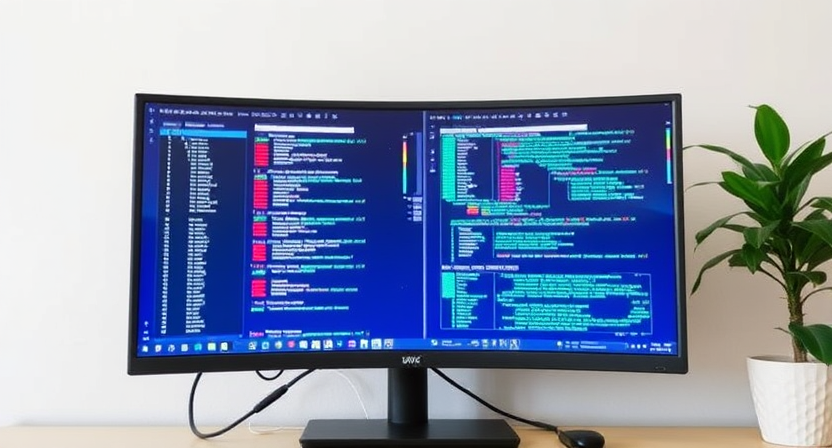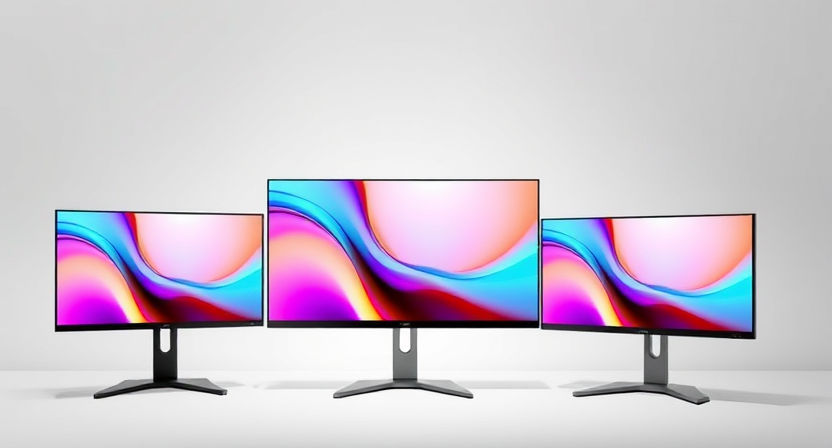Programming efficiency matters. Programmers seek tools and arrangements to streamline their work and eliminate distractions. Programmers may benefit from a Vertical Monitor, is it worth it? We’ll discuss why programmers use vertical monitors, how to determine the proper size, and the ideal configuration in this post.
Why Use a Vertical Monitor for Programming

Programmers can see more code without scrolling on a vertical display. This is beneficial for reading long papers, comparing code, or working with huge blocks of code. For tasks like troubleshooting or examining large logs, vertical displays are very useful. Programmers spend less time navigating through projects. bigger screen helps them focus and see more pertinent information.
Learn about 7 Tips for Choosing the Best Programming Monitor.
Vertical Monitors Improve Coding Efficiency: How?
Productivity Increase
Programmers prefer vertical displays for productivity. More code on the screen helps identify problems, comprehend context, and navigate the codebase, increasing productivity. Time saved by this efficiency is vital for meeting deadlines and maintaining workflow.
Spatial Optimization
Screen Property Improvement Programmers that prefer a single screen can display more code on a vertical monitor like the RD280UA with a 3:2 aspect ratio. Rotating the RD280UA vertically increases code visibility.
Effective Desk Space Use
Vertical monitors like the RD240Q are great for multi-monitor setups with limited desk space. It stacks monitors vertically to maximize content view and save desk space. This design offers multi-screen benefits without taking up too much horizontal space, making it efficient and practical.
Versatility
Vertical displays are flexible too. BenQ’s RD series monitors let users easily convert between portrait and landscape modes to suit their job. To improve user experience, the displays include Coding and ePaper color profiles.
Picking the Right Vertical Monitor Size

Size matters picking a vertical monitor. If misaligned, larger displays can strain the neck. Long-term portrait use is more comfortable on smaller displays.
The optimal vertical monitor size relies on workspace and personal choice. The BenQ RD line of 24–28-inch monitors strikes a nice mix between visibility and comfort. The 28.2-inch RD280UA’s 3:2 aspect ratio and 4K+ UHD resolution allow it to display many lines of code maintaining text clarity.
Other than size, consider the monitor’s resolution and aspect ratio.WQXGA on the RD240Q and 4K+ UHD on the RD280UA offer sharp, easy-to-read text. The 16:10 and 3:2 aspect ratios of the RD240Q and RD280UA provide extra vertical room for coding.
Panel type matters too. IPS panels on BenQ’s RD series displays provide wide viewing angles and continuous color fidelity for extended coding sessions.
Vertical Monitor Setup for Best Coding
1. Ergonomics and Comfort
A vertical display needs correct configuration to work well. To avoid neck strain, place the display at eye level with the top slightly lower. A natural line of sight and less pain extended coding sessions are achieved with this configuration.
2. – Monitor Setup
A vertical monitor beside a horizontal one is common among programmers. For best efficiency, utilize the vertical display for coding or documentation and the horizontal monitor for testing, browsing, or conversation. BenQ’s RD series displays’ adjustable stands and ergonomic features make dual-monitor setups easy and pleasant.
3. Possible Drawbacks and Solutions
Vertical displays have numerous benefits, but improper setup can cause pain. Neck discomfort is typical with bigger displays. Adjustable stands like BenQ’s RD series and a suitable display height can prevent this. The RD series’ Display Pilot 2 software streamlines portrait mode transitions and screen interface adjustments. Auto Pivot turns the OSD the display is upright on the RD240Q.
Another factor is compatibility. Not every software or hardware supports portrait mode, so verify before switching. Be sure to verify; most recent IDEs and coding tools support portrait mode.
Programmers’ Vertical Monitor Setup FAQs

Are Vertical Monitors Better for Coding?
Vertical displays display more code lines, making them ideal for coding. This reduces scrolling and organizes code. The 16:10 and 3:2 aspect ratios of BenQ’s RD240Q, RD280U, and RD280UA monitors enhance this. Vertical space is available without portrait mode on these displays. They give programmers greater vertical viewing space than 16:9 displays, letting them see more stuff at and improving attention and efficiency.
Is 27″ Too Big for a Vertical Monitor?
Sometimes a 27-inch monitor is too tall for vertical usage, causing neck pain. It depends on personal choice and workspace setup. A 27-inch vertical display with an adjustable monitor stand may provide a wide perspective for long coding sessions. For comfort, 24–28-inch monitors like the BenQ RD series are ideal.
Does Any Monitor Work Vertically?
Many recent monitors may be used vertically, provided they feature a pivoting stand or VESA mount. Monitor software or the operating system generally allows portrait mode rotation. Some displays may not be appropriate for vertical viewing, so check the aspect ratio and resolution. BenQ’s RD series displays include flexible mounting options for vertical configurations.
Check out GizOasis more to stay connected.







